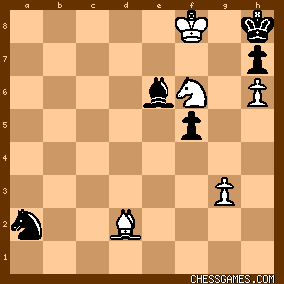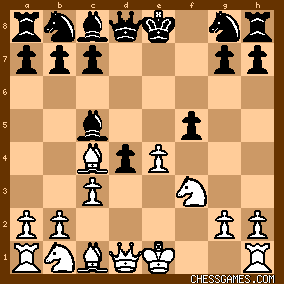| Dec-14-07 | | whiteshark: 
click for larger viewThe ♘f6 if not neccessary for mating.
<62.Nd5!> or any other ♘move except Nxh7 |
|
| Dec-14-07 | | D4n: Mate on move #64 Bf6, or Fischer could have traded Knights...either way it is still a mate. |
|
| Nov-30-08 | | Helios727: Why didn't black win a pawn with 42... Bxc6 43. Nxc6 Kxc6 ? |
|
| Dec-01-08 | | guaguanco: 42...Bxc6
43. Nxc6 Kxc6
44. Kd4 (black knight in danger) Kb5
45. Kd5 and moves to the kingside pawns
black will still have to waste time extracting his knight |
|
| Jul-26-10 | | newzild: Actually, after 42...Bxc6 43.Nxc6 Kxc6 44.Kd4, Black should not play 44...Kb5. He's better off ditching the knight, because if White tries to hunt down the knight with his king then black has time to exchange off the kingside pawns with the help of his king. If black abandons his knight and sends his king over to the kingside, and white also sends his king to the kingside, then the position is drawn in my opinion because white can't use his bishop to create a zugzwang without releasing the Na2. In my opinion, the position after 42...Bxc6 is therefore drawn with best play. I'd be interested to hear the opinions of any endgame experts on this. |
|
Nov-30-10
 | | HeMateMe: Bob strangles a weakie in the KGA. I play the KGD in blitz. A lot of KG blitz players arent' used to people playing a quiet decline line. The GMs don't use it, but it can work against club players. |
|
| Nov-30-10 | | Shams: <HeMateMe> Do you play 2...Bc5, 3...Nf6 and 4...d6<?> |
|
Nov-30-10
 | | HeMateMe: Yes, those are my moves. Its very quiet, but a lot of KG players don't practice the declined side, because they don't see it too often. black has to be very careful because of that open f file, but black's dark bishop gives counterplay, and black can open the center, after some prep moves. |
|
| Nov-30-10 | | Shams: <HeMateMe> Very dangerous for both sides is 1.e4 e5 2.f4 Bc5 3.Nf3 d6 4.c3 f5! Do you have any experience in this line? A model game is Gallagher - Kosten, not in the database (I forget the year.) White continued 5.fxe5 dxe4 6.d4 exd4 7.Bc4 (see diagram; the sharp 7.e5!? is also possible) 
click for larger view...fxe4 8.Ng5 Nf6 9.Nf7 Qe7 10.Nxa8 when black has fearsome attacking possibilities. Against best play, Gallagher and Andrew Martin suggest white has nothing better than repeating moves a ways down the road. Let me know if you have any fun in this line. I have a bit of analysis I transcribed from an Andrew Martin dvd; let me know if you're interested. |
|
| Nov-30-10 | | Shams: Sorry, that should be 5...dxe5 below. |
|
Dec-01-10
 | | HeMateMe: Looks interesting. Most of my chess is in online blitz, where I don't do so well at open board tactics. when I see the Kings Gambit, I play the quiet declined variation that you mentioned before. I've lost too many blitz games, with black against he KGA. A lot of club players are so used to playing the wild tactics on the kings side that they aren't at their best when this opening is semi closed. It has a losing record in the data base here (my variation), but I do ok with it in online blitz. However, if I meet that patzer Kramnik, or Judit Polger, I'm gonna play the KGA and open a can of Whup A__! |
|
| Dec-01-10 | | Shams: Fair enough, but with just a little work you get all the fun-- a huge attack where even a booked-up white has to force a draw. What's not to love? I admit, as a king's bishop's gambit player, I hate playing the KGD. |
|
| Nov-29-14 | | TheFocus: From a simul in Detroit, Michigan on February 9, 1964. Fischer scored +47=2-2. |
|
Feb-10-17
 | | wwall: Perhaps the losing move was 54...Bd5 since White has threats to fork bishop and king later on. Better may have been 54...Bc4 55.Ne6 Kf5 56.Nf8 h5. After 54...Bd5, White had 55.g4! h5 (55...h6 56.h5+ Kh7 57.Kxf6) 56.Ne2 Kg7 57.Ng3 hxg4 58.Nh5+ Kg6 59.Nf4+, which should win. In the game, instead of 55...Bc4? (55...Bxe6 56.Kxe6 h5 57.Ke7), perhaps better for Black is 55...Kf5 56.Nf8 (56.Ng7+ Kg4) 56...h5 with more resistance. Besides the game move 56.Nf8+, Fischer could have played 56.g4, threatening 57.g5 mate. After the game move 57.h5, instead of 57...Bb3, Black could have tried 57...h6, but White wins after 58.Ne6+ Kh7 59.Nd4 (59.Kxf6 Be2) 59...Bf1 60.Kxf6 and wins. |
|
Apr-05-19
 | | GrahamClayton: A single bishop mate (63. ♗g5 and 64. ♗f6#) is one of the rarer checkmate motifs. |
|
| May-26-20 | | Damenlaeuferbauer: With 42.c6 Bobby just bluffed successfully. In a practical (not theoretical) sense, 42.-,Bc8 was the losing move. 42.-,Bxc6 43.Nxc6,Kxc6 44.Kd4,g5! (trying to reduce the number of pawn) 45.hxg5,fxg5 46.g4,h6 47.Ke4,Kc5 48.Kf5,Kc4 49.Kxh6,Kd3 50.La5,g4 51.Kg5,Ke3 52.Kxg4,Nc1 or 46.Ke4,h5 47.Kf5,h4 draws. I am sure the great endgame expert and calculator saw this. This game reminds me a little of the famous encounter Fischer vs. Taimanov, Vancouver (m/2) 1971. |
|
| Mar-24-22 | | saturn2: Black had the bishop pair and gave it up with 10...Bd6. Instead 10...Ba6 keeps the advantage. |
|
Aug-21-24
 | | GrahamClayton: A hard fought win by Fischer in the first exhibition of his 1964 US tour. <John Donaldson> mentions in <A Legend On The Road - Bobby Fischer's 1964 Simultaneous Exhibition Tour> that many of the other players had already lost, and Witeczek was having less time to think as Fischer was coming around to his board faster and faster the longer the game went on. |
|
Sep-02-24
 | | Knightf7mate: A very good performance by Witeczek, whose bio is worth reading. I came across this game while reviewing all Fischer games exceeding 60 moves. I hope Fischer complimented Witeczek afterwards. JACK WITECZEK
(born Aug-01-1937, died Jun-1983, 45 years old) Poland (federation/nationality United States of America)
[what is this?]
Dr. Jack P. Witeczek, born in Lodz, Poland, was an American chess master. In 1960, he won the Ohio Chess Championshhip. In 1964, he won the Michigan Chess Championship. He appeared on the cover of the October 1966 issue of Chess Review for winning the 12th Annual Golden Knights Postal Chess Championship and the First Annual United States Open Postal Championship, which began in 1958. He had 23 wins and one draw in the event. He had a PhD degree in physical chemistry. |
|
Sep-02-24
 | | Knightf7mate: After move 27 when all the rooks come off, it’s virtually an even game with only the barest advantage for white. If you give either side to any two players of equal strength, most games would end in draws. This game shows Fischer’s strength in the endgame, compared even to a chess master. 1) +0.20 (26 ply) 28.Bf2 Ba6 29.g4 Kf7 30.Kg2 Ke6 31.Nc2 a4 32.Nd4+ Kf7 33.Kh2 Nc5 34.Be3 Ke8 35.Kg3 Kd7 36.Kf4 axb3 37.axb3 Nd3+ 38.Ke4 Nc5+ 39.Kf3 Ne6 40.Nxe6 Kxe6 41.Bc5 Bc8 42.Ke4 g6 43.b4 h5 44.b5 cxb5 45.cxb5 Bd7 |
|
Sep-02-24
 | | Knightf7mate: Graham’s comments from the book are amusing. Here you are, very pleased that you are playing even with Bobby move for move well into the midgame. Then all the weaker players fall by the wayside and now Fischer is at your board every 30 seconds or so and you find yourself up against the Herczig Novi Master!!! |
|





